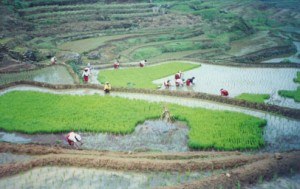- Never mind big-auto, bail-out for big cheese.
- Millennium Seed Bank (still) pleading poverty.
- Kimani avoids crops, one day at a time.
Nibbles: Early diet, Rice, Veggies, Barley, Research, Taiwan, Coffee trade
- Early Peruvians didn’t brush their teeth. On the plus side, they had a tasty, varied diet.
- Mangrove rice farming in West Africa: The Book.
- “Could it be that vegetables are the new meat?“
- Wild relative rescues barleys threatened by Russian pests.
- Gates supports McKnight supports poor farmers.
- Vavilov does Formosa.
- Ethiopian Commodity Exchange gets to grips with coffee. Starbucks unavailable for comment.
Australia’s forage genebanks to be mothballed?
The Seed Hunter now has a blog, and is using it to expose the “national scandal” of Australia’s disappearing forages collections. Read it and weep. Welcome to the blogosphere, Ken.
Input fairs: the view from the ground
One of the FAO’s preferred responses to food emergencies is the Input Trade Fair. Farmers receive a voucher, which they can exchange for seeds and other inputs that they need for a better harvest. In 2007, for example, 20,000 government-selected families in central and eastern Swaziland received vouchers that they could spend at one of 25 Input Trade Fairs. Earlier this year, FAO described these fairs as “winners”. But as the 2008 planting season gets under way, the news from Mbabane is not good.
 A report carried by IPS says that Swazi Input Fairs [are] Falling Short. Far fewer farmers have received vouchers this season. In the wake of rising prices the vouchers are not enough to purchase all the inputs needed. More vendors have entered the market, cutting down on sales for existing vendors. But most worrying of all, according to the report most of the subsistence farmers who have benefited from the scheme are no nearer being able to stand on their own feet than they were before the scheme started. Some, it is said, have no real interest in farming. They are just hungry, and wash the pesticidal dressings off the seeds before cooking and eating them. Many farmers refuse to switch away from maize, which needs far more water than crops such as sorghum.
A report carried by IPS says that Swazi Input Fairs [are] Falling Short. Far fewer farmers have received vouchers this season. In the wake of rising prices the vouchers are not enough to purchase all the inputs needed. More vendors have entered the market, cutting down on sales for existing vendors. But most worrying of all, according to the report most of the subsistence farmers who have benefited from the scheme are no nearer being able to stand on their own feet than they were before the scheme started. Some, it is said, have no real interest in farming. They are just hungry, and wash the pesticidal dressings off the seeds before cooking and eating them. Many farmers refuse to switch away from maize, which needs far more water than crops such as sorghum.
While an on-the-spot report such as this one offers some insights, it does not indicate how Swaziland’s drought-stricken farmers could best tackle their problems. Maybe they need more extension help, to show them how to make better use of their inputs. Maybe they need radical changes in their methods. I was at a meeting in London on Wednesday where I saw a very short video called Greening the Desert. Geoff Lawton, of the Permaculture Research Institute of Australia, explained in tantalizing snippets how he had transformed a barren patch of Jordan into a flourishing orchard. No, I have not seen peer-reviewed results. But it seems worth trying elsewhere, and Swaziland could be a good place to do so.
Big cheer for the terraces
 Is this old news or not? The Global Environment Facility (GEF) in concert with FAO’s Globally Important Agricultural Heritage Systems, is funding the restoration and maintenance of the Ifugao rice terraces in the Philippines. My confusion arises because when I last nibbled Ifugao, 1 I don’t recall seeing anything about FAO’s involvement, and yet it seems to have been going since 2002. The “news” is announcing a second phase, which I think started in 2007. So perhaps my confusion is justified. In any case, it does seem important that these astonishing human impacts on the environment are used, rather than pickled, and that seems to be the goal of the project.
Is this old news or not? The Global Environment Facility (GEF) in concert with FAO’s Globally Important Agricultural Heritage Systems, is funding the restoration and maintenance of the Ifugao rice terraces in the Philippines. My confusion arises because when I last nibbled Ifugao, 1 I don’t recall seeing anything about FAO’s involvement, and yet it seems to have been going since 2002. The “news” is announcing a second phase, which I think started in 2007. So perhaps my confusion is justified. In any case, it does seem important that these astonishing human impacts on the environment are used, rather than pickled, and that seems to be the goal of the project.
I’m rather hoping that someone in the Philippines, or who knows more about the project, will be along soon to enlighten me further.